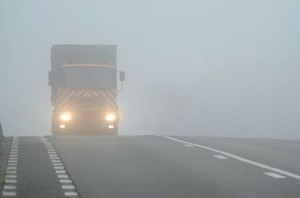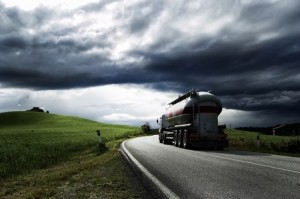
Basics
Weather is a factor is about 21% of vehicle crashes. Rain, snow, ice, hail, sleet, fog, mist, smoke, dust, extreme heat or cold and high winds are some examples. With global warming, bad road conditions caused by weather and environment conditions are becoming more common.
Reduced visibility and traction are two of the basic problems that bad weather conditions create. Reduced visibility interferes with the driver’s (including truckers) ability to see the road and other vehicles on it. This can increase the amount of time it takes for a driver to see and react to a hazard. Reduced traction is another problem that adverse weather can cause. Less traction can mean longer stopping distances, reduced ability to control and maneuver trucks. Both reduce the ability of semis and other large trucks to operate safely.
18 wheelers and other big trucks operate day and night and are exposed to a wide range of these adverse weather conditions making safe operation more difficult or impossible. Not surprisingly, each year weather caused bad road conditions cause of thousands of 18 wheeler accidents and other big truck wrecks. Wet roads alone were a factor in more than 12% of 2017 large truck crashes causing injury or death according to U.S. Government data.
Some of the primary weather conditions which cause hazards are:
Truck Wrecks on Ice & Snow
About 24% of weather-related wrecks happen on roads with snow, ice or slush on them. Each year these crashes cause more that 100,000 injuries and over one thousand deaths. Approximately 2.5% of injury truck crashes in 2012 occurred in snow or ice conditions according to Federal research.
Traction is essential for a truck driver to control a semi. Snow or ice covered roads severely reduce traction and the driver’s ability to maneuver and control the truck. Stopping distances also increase. One estimate is that traction is reduced by 80% on packed snow or ice. On snow packed roads a standard reference manual for truck drivers recommends that reducing speed by at least one-half. On icy roads the manual advises them to slow to a crawl and get off the road as soon as they safely can. Applying tire chains to the truck’s drive wheels (“chain up” in trucker lingo) can significantly improve traction, control, braking power and help prevent skids.
Snow and ice conditions can also reduce a truck driver’s ability to see through windows/mirrors and reduce the visibility and effectiveness of headlights, brake lights, turn signals and other lights on the truck.
Blowing snow can interfere with the air flow the truck’s engine needs to operate causing it to stall and the truck to stop. If the truck stops suddenly in a traffic lane it can create a traffic hazard on the roadway with the potential for other vehicles to crash into the disabled truck. The danger is further increased by the reduced visibility other vehicles on the road have due to the blowing snow and reduced traction they have and can create the conditions for a chain-reaction crash or highway pileup.
Other risk factors for truck accidents in snow are heavy snow, especially when coupled with shorter, darker winter days which can limit the visibility necessary for safe truck operation. Trucks are also more subject to equipment failure in these conditions. The reduced traction and visibility conditions snow and ice can be factors in truck wrecks like head-on and rear end crashes, sideswipe collisions, a jackknife, rear offset underride and other types of accidents.
Rain
 Fog
Fog
Fog can form quickly, limit visibility, increase crash risk and in a factor in approximately 1% of wrecks. The safe speed to operate a truck in fog depends on the visibility ahead. In some cases if visibility is to limited, it may be necessary for the truck driver to pull off the road until conditions improve. Truck wrecks which happen in fog conditions often involve high-speed impacts increasing the risk for fatalities. Because of fog, a truck driver may not be able to see the traffic lane lines potentially causing head-on or sideswipe collisions or vehicles ahead of it causing a rear end collision.
Some safety procedures for truck drivers to reduce the risk of being involved in a fog related crash include reducing speed, turning on the trucks lights and using fog lights (if available) and low-beams, activating four-way flashers, windshield wipers and the defroster and not driving when the fog is to0 thick.
Wind
18 wheelers and other big trucks are usually high profile vehicles. Wind can affect their stability. In some cases large van type trailers can catch the wind somewhat like a sail. This can make them harder to control or, in extreme cases, cause a semi or other trucks to rollover. Fully loaded trucks better resist the effects of wind because they are heavier. Empty trucks, which are lighter, are more subject to being affected by high winds. While wind is factor it often combines with other road conditions like rain and wet roadways to cause a truck crash.
Hot Weather
Hot weather and/or extreme heat can create many mechanical problems for semis and other big trucks. One major area affected by heat is tires. A truck’s tires can overheat causing a blow out or a recap to fail and to come off the. These can cause the truck to loose control or create a road hazard for other vehicles on the highway. The tire can also catch fire. Big heavily loaded trucks can also overheat and be subject to a range of other heat related problems.
Most large truck drivers are required to conduct a “pre-trip” inspection before starting to drive for the day. A properly done pre-trip inspection and identify and provide the opportunity to fix many defects which could cause a dangerous situation on the road.
Extreme Cold
It’s common knowledge that cold often adversely affects mechanical equipment. Just think about how your car can be harder to start in cold weather conditions than when it is warmer. Semis and other big trucks are typically have more complicated mechanical systems than your average passenger car. Most use air brake systems which require on a network of air lines. In extreme cold moisture in the brake system air lines can condense and form ice interfering with the air brakes proper functioning. Extremely low temperatures can cause metal parts can become more brittle, subject to fail and cause problems with a variety of the truck’s other systems. Extreme cold can also be harder on truck drivers causing them to become fatigued more readily.
Other
Among the other weather conditions which can negatively affect truck safety and be involved in truck crashes are: sleet, smoke, dust or blowing materials.
Federal Motor Carrier Safety Regulations- Hazardous Conditions
 Federal Motor Carrier Safety Regulations require truck drivers exercise extreme caution and reduce speed in hazardous conditions when rain, sleet, snow, ice, dust, mist, smoke or fog negatively affect traction or visibility. If the conditions are dangerous enough, the driver is generally not permitted to drive and must wait until the vehicle can be operated safely. Industry materials instruct truck drivers to slow down by 1/3 on wet roads and at least 1/2 on packed snow. On icy roads truck drivers are told to slow down to a crawl and get off the road as soon they safely can. Your 18 wheeler crash attorney should determine whether weather conditions were a factor in your crash and use the above, if applicable, in your case.
Federal Motor Carrier Safety Regulations require truck drivers exercise extreme caution and reduce speed in hazardous conditions when rain, sleet, snow, ice, dust, mist, smoke or fog negatively affect traction or visibility. If the conditions are dangerous enough, the driver is generally not permitted to drive and must wait until the vehicle can be operated safely. Industry materials instruct truck drivers to slow down by 1/3 on wet roads and at least 1/2 on packed snow. On icy roads truck drivers are told to slow down to a crawl and get off the road as soon they safely can. Your 18 wheeler crash attorney should determine whether weather conditions were a factor in your crash and use the above, if applicable, in your case.
In the event of a truck accident, there are often serious and even tragic consequences. If you or someone you love has been seriously injured, disabled, or killed in a trucking accident caused by poor road conditions or poor weather conditions, call Flick Law Firm as soon as possible.
LAWRENCE FLICK LAST REVIEWED AND EDITED THIS PAGE ON MARCH 22, 2021










